Personal Information Management Systems: Organize Your Data
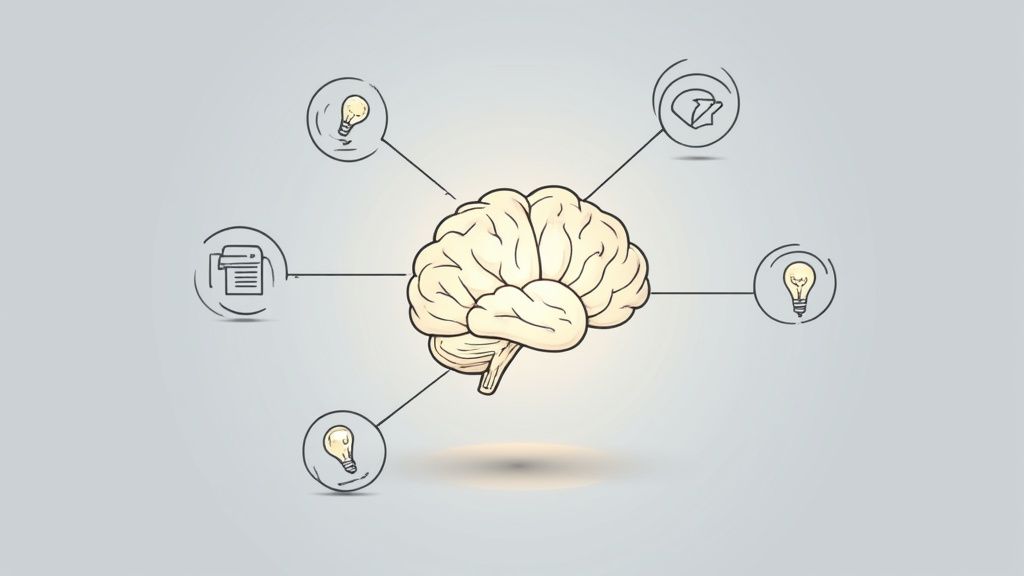
Personal information management systems (PIMS) are the frameworks we use to capture, store, organize, and find the constant flow of data in our lives. Think of a PIMS as a central command center for your personal and professional knowledge—everything from project notes and daily tasks to creative ideas and long-term goals. It’s a strategic way to handle information overload.
What Is a Personal Information Management System
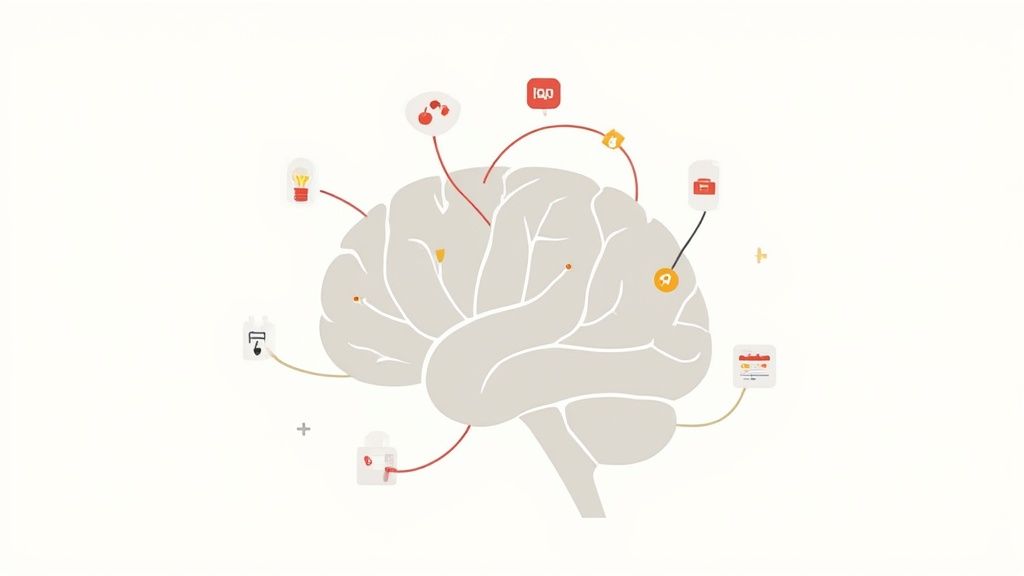
Imagine if your brain had an external hard drive. It would be a place where you could offload every fleeting thought, important link, meeting note, and brilliant idea without the fear of forgetting it. That’s the core idea behind today's personal information management systems. These systems are much more than just digital filing cabinets or basic note-taking apps.
A PIMS is really a cohesive ecosystem designed to fight back against the daily flood of information. Every single day, we're hit with a massive amount of data:
Project updates and action items from work.
Interesting articles and research papers for a personal project.
Reminders for appointments and family events.
Sparks of inspiration for a new hobby or creative endeavor.
Without a system in place, all this information ends up scattered across email inboxes, random documents, sticky notes, and browser bookmarks. This digital clutter creates mental friction, making it nearly impossible to find what you need, when you need it. A PIMS gives you a single, trusted place for everything, which reduces your cognitive load and frees up your mind to focus on what really matters: thinking, creating, and making decisions.
From Static Files to a Second Brain
The way these systems have evolved is pretty significant. Early versions were often rigid, folder-based setups that demanded tedious manual organization. Today’s tools, however, act more like a networked "second brain." They use things like tags, backlinks, and smart search to build connections between bits of information that might seem unrelated.
For example, a note from a client meeting can link directly to a project task, a relevant research article, and a personal reminder. This interconnected approach mimics how our own minds work, building a web of knowledge that gets more valuable over time.
A well-implemented PIMS doesn't just store information; it creates a space where new ideas can collide and generate insights you might have otherwise missed. It turns passive data collection into an active process of knowledge synthesis.
The Role of Obsibrain and Structured Organization
To build an effective PIMS, you need a clear organizational framework. It’s key. Tools like Obsibrain, which is built on the powerful foundation of Obsidian, provide the structure needed to manage all this complexity. A student, for instance, could use Obsibrain's pre-built structure to organize lecture notes, research papers, and assignment deadlines, linking them all to a central "Semester Goals" page for a clear overview of their academic progress.
Systems like the P.A.R.A. method give you a blueprint for sorting your digital life into actionable areas. You can learn more by exploring the P.A.R.A. folder structure for a proven approach.
Of course, managing your data effectively isn’t just about convenience; it's also about security. To really grasp its importance, it's crucial to understand the landscape of digital security and pick up some essential tips for protecting personal information online. By pairing a robust tool with a sound methodology, you can transform your digital chaos into a powerful personal knowledge base.
The Core Functions of an Effective PIMS
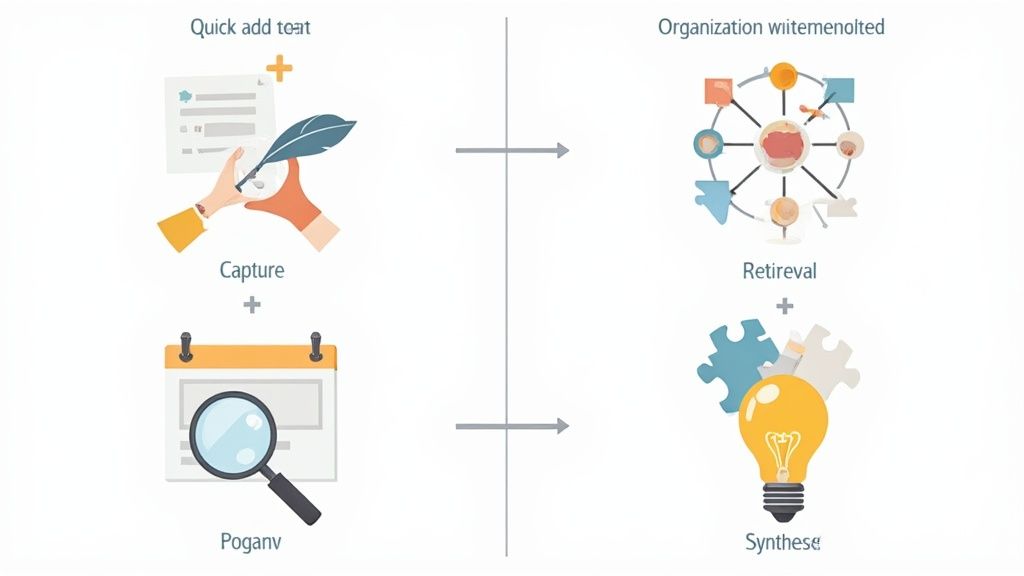
At its heart, any PIMS worth its salt is built on four fundamental pillars. These aren't just features; they're the core actions that turn a simple pile of notes into a powerhouse for thinking and creating. When Capture, Organization, Retrieval, and Synthesis all work together, your system stops being a digital junk drawer and starts becoming an extension of your own mind.
Think of it like building a personal library. You need a way to bring new books in (Capture), a smart system to arrange them (Organization), a foolproof way to find any book you need (Retrieval), and the ability to pull ideas from different books to create something entirely new (Synthesis). If any one of these steps is weak, the whole library falls apart.
Effortless Capture
First up, and arguably the most critical, is Capture. Let's be honest: if saving an idea to your system is a pain, you just won't do it. The whole point is to get thoughts out of your head and into your PIMS with zero friction, right at the moment of inspiration.
This means your tools have to move as fast as you think. A great PIMS offers things like global hotkeys to summon a new note from anywhere on your computer or a quick-add button on your phone that’s always one tap away.
Obsibrain, for example, is built around this idea of instant action. You can see how its quick capture and notes features are designed to make sure no good idea is ever lost to distraction or a clumsy interface. A truly effective PIMS makes capturing information feel like second nature.
Flexible Organization
Once your information is in, you need a way to organize it. This is where modern systems have completely left the old "digital filing cabinet" model in the dust. For decades, we were stuck with rigid folder structures, forcing every single piece of information into one specific box.
But ideas are messy. They don't fit neatly into one category. A note about a marketing campaign might relate to your "Work" folder, but also your "Projects" folder, and maybe even a personal "Creative Ideas" folder. Old systems made you choose just one.
Modern PIMS solves this with a much more brain-like approach: tags and bi-directional links. Instead of cramming a note into a folder, you simply connect it to multiple concepts. This creates a rich web of knowledge where everything can live in multiple contexts at once.
This networked approach mirrors how our own minds work, connecting ideas in complex, overlapping ways.
Traditional vs Modern PIMS Organization Methods
Let's break down just how different these two organizational philosophies really are. The old way forces you to be a librarian; the new way lets your knowledge organize itself.
Structure
Rigid and hierarchical. A file can only live in one folder at a time.
Flexible and networked. A note can be linked to many different contexts.
Discovery
Relies on remembering exactly where you filed something. Good luck.
Surfaces related ideas automatically through links and shared tags.
Flexibility
A nightmare to change. Reorganizing means manually moving everything.
Easily adapts as your projects and interests evolve over time.
As you can see, the flexibility of a modern system isn't just a minor improvement—it’s a complete shift in how you interact with your own knowledge.
Swift Retrieval
All the notes in the world mean nothing if you can't find what you need, when you need it. Retrieval is the ability to pull the exact nugget of information you're looking for, instantly. This is about more than just a basic search bar.
A powerful PIMS offers robust search tools, letting you filter by tags, dates, linked mentions, and even fuzzy or incomplete phrases. The goal is to feel like you're asking a super-smart assistant a question and getting the perfect answer back every time. That reliability is what builds real trust in your system.
Creative Synthesis
Finally, we arrive at the most powerful function of all: Synthesis. This is the magic step where your PIMS stops being a storage unit and starts being a creative partner. Synthesis is the act of connecting scattered ideas to form brand-new insights.
By using bi-directional links, you can see not just where a note is pointing, but all the other notes that point back to it. This is huge. It reveals hidden connections between ideas you might have captured months or even years apart.
This is what turns your stored data into actionable intelligence, transforming your PIMS from a passive archive into an active tool for thinking.
How a PIMS Can Transform Your Work and Life
Taking on a personal information management system isn't just about tidying up your digital life. It's about fundamentally changing how you think, work, and create. When you start externalizing that constant stream of thoughts, tasks, and data from your mind into a system you trust, something amazing happens. You dramatically cut down on mental clutter and that low-grade stress that comes from trying to remember everything all at once.
Think of it like offloading dozens of open browser tabs from your brain. All of a sudden, your mental bandwidth is freed up. Instead of burning energy juggling reminders and hunting for scattered bits of information, your mind can finally focus on what it does best: deep thinking, creative problem-solving, and genuine innovation.
Real-World Productivity Gains
The impact of a well-structured PIMS is tangible across just about every professional field. It's not abstract theory; let's look at a few real-world scenarios where these systems become absolutely essential.
For the Academic Researcher: Imagine trying to manage hundreds of academic papers, annotations, and citations. It’s a massive undertaking. A PIMS lets a researcher link concepts across different studies, bring up related notes from months ago, and build a connected web of knowledge that makes writing a thesis or dissertation far more manageable.
For the Project Manager: Juggling emails, meeting minutes, Slack messages, and project files is a classic recipe for chaos. A PIMS centralizes all those communication streams. It links action items directly to project goals and team members, creating a single source of truth that keeps everyone on the same page.
For the Entrepreneur: You're tracking market trends, competitor analysis, customer feedback, and new business ideas all at once. A PIMS helps an entrepreneur connect these disparate pieces of information to see the bigger picture, spot patterns, and make smarter, data-driven decisions—like linking a specific customer insight directly to a potential new product feature.
In every one of these cases, the PIMS is more than just a storage container; it’s an active partner in hitting your goals. It goes way beyond just organizing data. A PIMS is a powerful tool designed to significantly boost personal productivity by bringing clarity and focus to your work.
A PIMS acts as your "second brain"—a reliable extension of your own mind. It remembers everything for you, so you can focus on the thinking, not just the storing. This shift from simple recall to deep analysis is where real breakthroughs happen.
From Information to Insight with Obsibrain
This is exactly where a tool like Obsibrain, built on top of Obsidian, really shines. It doesn't just help you file away notes; it helps you build a dynamic knowledge base that actively works for you.
Take a freelance writer using Obsibrain, for example. They can manage multiple client projects without breaking a sweat. Notes from a client call can be instantly linked to the project outline, relevant research articles, and specific tasks with due dates. As they write, Obsibrain’s structure helps surface related ideas from past projects, sparking new angles for their articles and stopping creative blocks before they even start.
This integrated approach means the writer spends less time digging for information and more time creating great content. The system proactively connects the dots, turning a simple collection of client notes into a powerful engine for creativity and efficiency. The result isn't just better work, but a far more streamlined and less stressful creative process.
Choosing the Right PIMS for Your Needs
Jumping into the world of personal information management systems can feel like trying to drink from a firehose. There are so many tools out there, and each one seems to have a legion of die-hard fans. It's easy to get lost.
The trick isn't finding the single "best" app—it's about finding the one that clicks with how you think and work. A common mistake is grabbing the most popular tool, only to find it fights you every step of the way. What works for a big, structured team might feel like a straitjacket for a solo creative. You have to look past the flashy feature lists and get to the heart of how each tool operates.
First, Figure Out What You Actually Need
Before you even open a new browser tab, take a minute to think about your own requirements. A few honest answers here will save you a ton of time later.
What kind of stuff am I actually managing? Is it mostly structured info, like project plans and client lists? Or is it a chaotic jumble of ideas, research snippets, and random thoughts that need to be connected?
Where does my data live? Am I okay with my information sitting on a company's cloud servers, or do I need it stored locally on my own machine, completely under my control?
How much do I want to tinker? Do I need a system I can customize down to the last pixel, or would I rather have a simple, ready-to-go experience right out of the box?
These questions are your filter. They’ll help you cut through the noise and zero in on the tools that are actually built for someone with your specific needs.
It’s All About the Philosophy
Different PIMS tools are built on wildly different ideas about how information should be handled. Grasping this is the single most important step in making a good choice.
Think about the contrast between two popular options.
Notion is brilliant for building structured, collaborative spaces. It’s like a box of digital Lego bricks you can use to assemble databases, wikis, and project dashboards. It's a fantastic choice for teams or anyone who needs to keep information in neat, orderly rows and columns.
Obsidian, on the other hand, is built for networked thought. It puts you in complete control with a local-first approach, meaning your data lives on your device. Its real power is in connecting notes with bi-directional links, creating a web of knowledge that mirrors how your own brain works.
This philosophical difference is crucial. Notion asks you to fit your information into its structure; Obsidian gives you the freedom to let your information create its own structure.
This isn't just a minor detail; it completely changes how you interact with your knowledge. For instance, someone using Obsibrain to manage their personal goals isn't just making a list. They can link a high-level goal like "Learn a new language" to specific weekly tasks, relevant online courses, and notes on grammar rules. This creates a rich, interconnected dashboard for their goal that a simple checklist simply can't match.
The explosion of tools like these is no accident. The global Product Information Management (PIM) market was valued at $15.62 billion and is expected to nearly double by 2029. This trend shows just how badly people need better ways to organize their digital lives. You can read more about these PIM market statistics to see just how big this movement is.
The infographic below shows how simply committing to a PIMS can be the first step toward a more organized life.
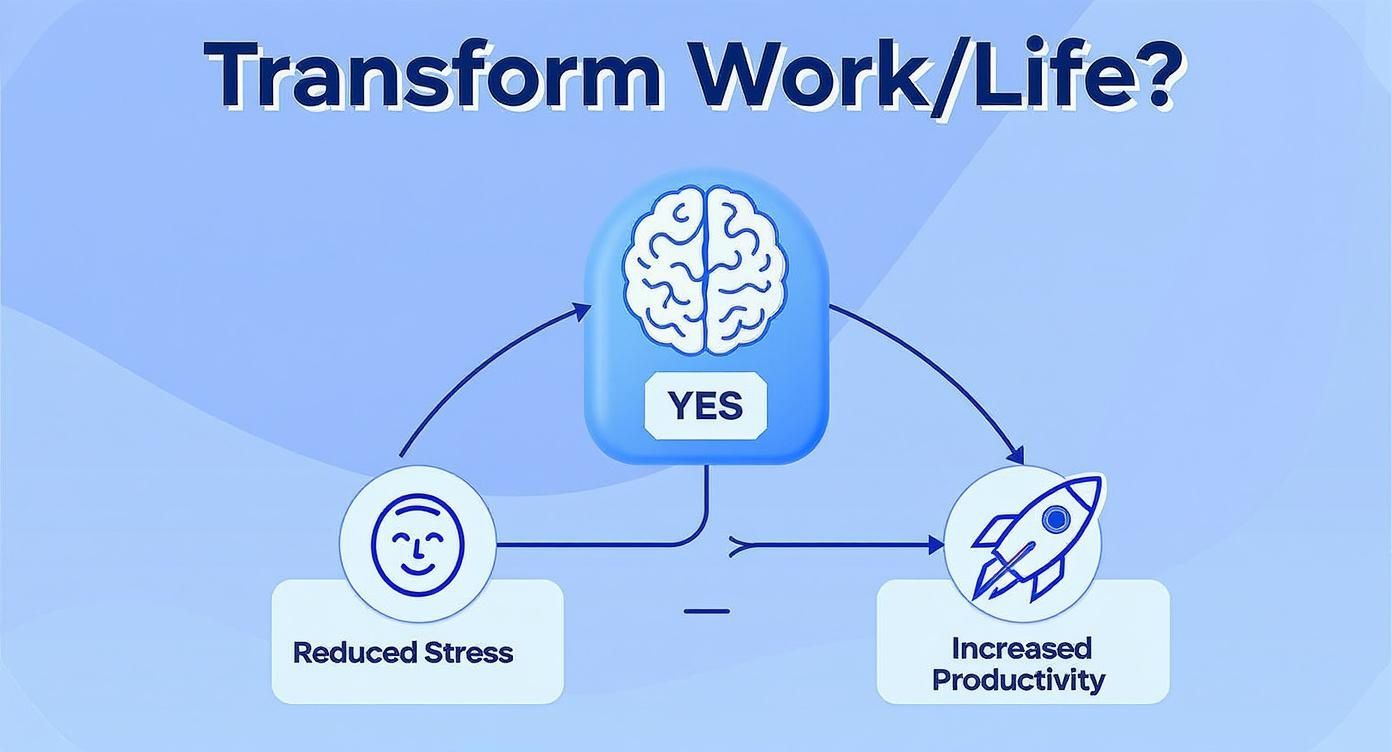
As you can see, the path from adopting a system to achieving real benefits like less stress and more focus is a direct one.
Popular PIMS Tools at a Glance
To help you see the philosophical differences in action, here’s a quick comparison of some of the top contenders in the PIMS space.
Obsidian
Networked Thought & Knowledge Linking
Local-first (plain text files)
Thinkers, researchers, and anyone building a long-term "second brain."
Notion
All-in-One Structured Workspace
Cloud-based
Teams and individuals who need structured databases, wikis, and project plans.
Digital Filing Cabinet
Cloud-based
Capturing and organizing everything from web clips to documents in one place.
Outlining & Networked Thought
Cloud-based
Academics and writers who think in outlines and want to connect ideas fluidly.
This table just scratches the surface, but it highlights how the core idea behind each tool shapes who it’s best for.
Making a Decision for the Long Haul
Ultimately, the best PIMS is the one you’ll stick with. Think about where you see yourself in five or ten years.
If you value data ownership, privacy, and building a knowledge base that will last a lifetime, a local-first, plain-text tool like Obsidian is a stellar choice. When you add a system like Obsibrain on top, it becomes a powerhouse that can grow and adapt with you.
If your main goal is real-time collaboration and creating polished, shareable documents, a cloud-based tool like Notion or Evernote might be the smarter pick. The right choice should feel less like another piece of software you have to manage and more like a true extension of your own mind.
Building an AI-Powered PIMS with Obsibrain
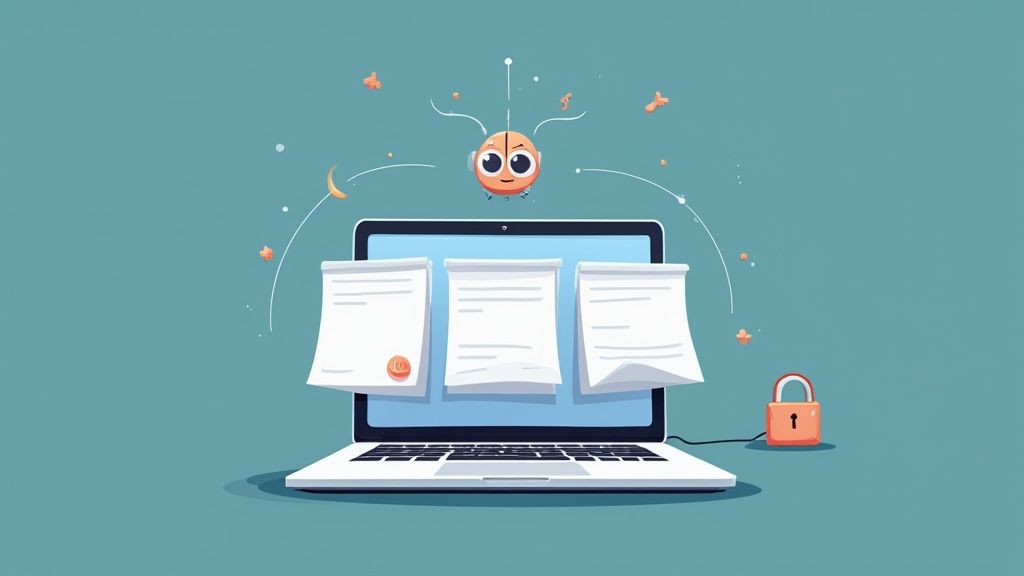
While most personal information management systems give you a place to dump your data, the real magic happens when that data starts working for you. This is exactly what happens when you combine a flexible tool like Obsidian with an intelligent framework like Obsibrain. You move past a digital filing cabinet and start building a proactive, AI-powered knowledge assistant that understands your life.
It all starts with Obsidian's core promise: data ownership and longevity. Unlike cloud tools where your notes live on someone else's server, Obsidian is local-first. Everything you create is a simple plain-text file stored on your own device. That’s not just a technical detail—it’s a guarantee of privacy, security, and control. Your system won't disappear if a company goes under or changes its policies.
Obsibrain builds on this solid foundation, adding a smart layer of structure and automation that turns your collection of notes into a dynamic "second brain." It’s designed to spot connections and offer insights, turning what you know into a powerful, active asset.
Transforming How You Interact with Information
Obsibrain isn’t just another template. It’s a complete system designed to fundamentally change your relationship with your own information. By giving you a clear structure for projects, goals, and ideas, it creates the perfect environment for AI-driven insights to emerge.
But the real power is in how it helps real people solve specific problems. Let’s look at a few practical examples that show the shift from simply storing information to actively creating knowledge.
Obsibrain for the Student or Researcher
If you're deep in academic work, you know the biggest challenge isn't finding information—it's connecting it all. A student juggling dozens of research papers and lecture notes can easily get lost in the details. This is where an intelligent PIMS becomes an essential research partner.
With Obsibrain, a researcher can jot down notes from a scientific paper and instantly link them to concepts from past lectures or other articles. As their knowledge base grows, the system starts doing the heavy lifting.
Automatic Thematic Connections: Obsibrain’s structure helps uncover hidden themes. When you tag notes with keywords, the system surfaces other notes with similar tags, revealing connections you might have otherwise missed.
Dynamic Summaries: Instead of manually piecing together findings, you can gather all linked notes on a single topic to generate a quick summary. This absolutely crushes the time it takes to do a literature review.
Question and Answer: You can essentially "ask" your vault questions. Searching for a term doesn't just pull up notes containing that word; it retrieves all the linked ideas connected to it, giving you a rich, contextual answer drawn from your own research.
This turns a static library of research into a dynamic thinking partner. Your PIMS actively helps you connect ideas and build new arguments, instead of just holding your highlights.
Obsibrain for the Creative Professional
Creative work runs on inspiration, which often sparks from connecting completely unrelated ideas. A graphic designer or writer might have hundreds of fleeting ideas and visual references saved over the years. A standard PIMS just stores them. An intelligent one helps you use them.
Obsibrain helps creatives push through blocks by serving as a muse built from their own past thinking. It can pull up a forgotten concept from three years ago that just so happens to be the perfect solution for today's project.
A writer stuck on a story could look at the graph view of notes tagged with "#inspiration" and see a visual web of their past ideas. This might ignite a new connection between an old character sketch and a recent article they saved, unlocking a completely new angle. The system transforms a cold archive into a warm source of unexpected discovery.
Obsibrain for the Project Manager
Project management is all about connecting people, tasks, and information. A project manager using Obsibrain can build a complete, interconnected view of every project without ever leaving their PIMS.
Imagine linking a meeting note directly to the action items discussed, the team members responsible, and the big-picture project goal. Every piece of data lives in a rich, meaningful context.
Complete Project Views: By opening a single project note, a manager can instantly see all related meetings, tasks, files, and communications linked to it.
Proactive Reminders: The system connects tasks to dates, meaning action items from a meeting automatically pop up in daily plans.
Searchable History: Need to know why a decision was made six months ago? A quick search brings up the exact meeting note, the people who were there, and all related documents, providing a perfect project history.
Getting started with a system this powerful is surprisingly simple. If you're ready to build your own intelligent PIMS, our guide on how to get started with Obsibrain offers a step-by-step walkthrough. This approach turns project management from a frantic hunt for information into a calm, controlled process.
Common Questions About Personal Information Management
Diving into the world of personal information management systems usually kicks up a few questions. Getting a handle on these from the start is the best way to build a system that actually serves you, clearing up the confusion so you can hit the ground running.
What’s the Real Difference Between a PIMS and a Simple Note-Taking App?
A simple note-taking app, like Apple Notes or Google Keep, is brilliant for catching those fleeting thoughts or quick reminders. Think of it as a digital sticky note—perfect for a grocery list or a phone number you only need for a few hours.
A true PIMS, on the other hand, is built for structure, connection, and long-term knowledge. It goes way beyond just capturing text. It’s about robust organization with tools like tags and backlinks, powerful search to find exactly what you need, and the ability to actually synthesize new ideas from the information you've gathered.
It's the difference between a stack of loose index cards and a personal library with an intelligent librarian who knows how every single book relates to the others. One is for temporary storage; the other is for building lasting wisdom.
How Do I Actually Get Started Building My Own PIMS?
Getting started is simpler than you might think. The biggest trap is analysis paralysis—trying to design the "perfect" system before you even have anything to put in it. A much better approach is to let it grow organically.
Choose a Tool That Fits: Pick a platform that feels right for you. If you care about privacy and love the idea of networked thought, something like Obsidian is a fantastic starting point. The goal is just to pick one and get going.
Capture Everything for One Week: For the next seven days, make it a habit to jot down anything that crosses your mind—ideas, links, meeting notes, tasks. Don't worry about organizing it yet. Just get it all into the system.
Start with Broad Tags: After a week, look back at what you've collected. You'll start to see patterns. Begin by adding a few broad tags like
#work,#learning, or#personal-projects.
The best structures evolve naturally from the content you create, not from a perfectly laid plan. The most important thing you can do is just start capturing information consistently.
Is My Data Safe in a Cloud-Based PIMS?
That's a critical question, and the answer really depends on what "safe" means to you. Big-name cloud services like Notion use strong encryption to protect your data, but that data lives on their servers. It’s subject to their terms of service and security policies, which means you aren't fully in control.
For maximum privacy and control, local-first applications like Obsidian are a much better bet. They store your files directly on your own device in a standard, open format like Markdown. This gives you complete ownership of your digital life.
This model is becoming more important as people wake up to data privacy issues. In fact, the market for data privacy software is exploding—it’s expected to hit $5.37 billion in 2025 and is projected to climb to an incredible $45.13 billion by 2032. This trend, which you can read about in this market analysis on data privacy software, shows a massive global demand for better data control. With a local-first PIMS, you're the one in the driver's seat.
Can a PIMS Really Make Me More Creative?
Absolutely. Creativity is often just about connecting existing ideas in new ways. A PIMS is the perfect playground for these kinds of "serendipitous discoveries." When your notes are linked together, you create a web of your own thinking.
A system like Obsibrain takes this even further. Imagine a writer working on a project who can instantly see every note linked to a specific theme. They might stumble upon a forgotten idea from years ago that provides the exact breakthrough they needed for their current creative block. For example, a hobbyist baker using Obsibrain could link a recipe idea to a note about a new baking technique they learned and another note about a friend's birthday, sparking the perfect cake idea.
Instead of just being a dusty archive, your PIMS becomes a dynamic space where ideas can collide and spark something entirely new. It turns your collection of notes into an active source of inspiration.
Do I Need to Be a Tech Whiz to Use a PIMS?
Not at all. While some systems offer deep customization that tech-savvy users love, the core functions are accessible to everyone. The best way in is to start simple.
Many people find that a pre-built template is the perfect on-ramp. A system like Obsibrain, for example, gives you a complete framework for Obsidian right out of the box. You immediately get the benefits of best practices for task management, goal setting, and note organization without having to build it all from scratch.
This lets you focus on what really matters: capturing your ideas and building your knowledge base. You can always learn the more advanced features as you go, but you can start reaping the rewards of a powerful PIMS from day one, no matter your skill level.
Ready to stop juggling apps and build a true "second brain"? Obsibrain provides the complete, all-in-one system you need to centralize your tasks, notes, and goals inside Obsidian. Start transforming your productivity today with Obsibrain.
Last updated
Was this helpful?